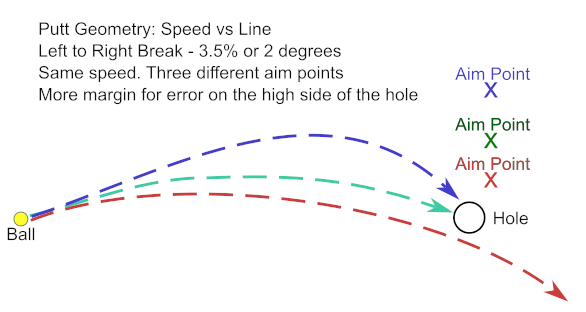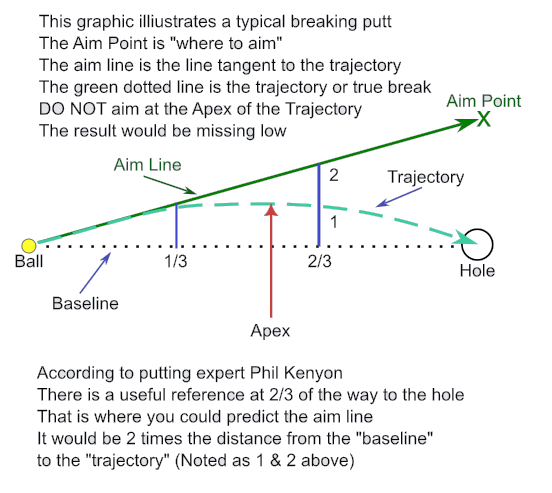There are several important factors in putt geometry that are critical to green reading. Let’s take a look at the building blocks of a successful putt.
Putt Geometry – Speed vs Line
The simple rule to remember: “There is always more than one line above the hole on a breaking putt.”
In other words, there is more margin for error on the high side of the hole.
I’ve used The Perfect Putter to find multiple lines above the hole using the same speed.
By playing more break the ball may slow down, but it will still go in the hole.
Where you get into trouble is aiming too low on breaking putts.
Some people would say, “You missed because your speed was way off.” That might not be the case.
If you putt too low, the ball picks up speed because you misread the putt. The downhill break causes it to pick up speed and go way past the hole.

Video – Reading Putting Greens | Titleist Tips
Video – Make More Breaking Putts! Improve Your Aim Line!
Putt Geometry – The Apex
Another critical factor in putt geometry is your start line.
Green reading is not a perfect science. However, there are ways to get yourself in the ballpark.
What do I do?
I am a linear putter. I putt to an aim point at the end of my aim line or start line.
My aim line is tangent to the trajectory the ball is taking to the hole.
Seeing putt geometry and determining where that tangent line is can be a challenge.
I see the break in degrees and use a chart in practice to help with break.
There are charts in percent of slope and degrees of slope on our Putting Resources page.
I’ve measured the slope on our greens with a Breakmaster and now I can see 1 degree, 2 degrees, etc. It takes practice.
When I read a putt, I say to myself “This is the degree of slope.” “From this many feet from the hole, I need to aim this far to the right or left” based experience and practice.
I do visualize the ball breaking into the hole, but my focus is on an aim point. It becomes a straight putt every time I putt. Straight at an aim point.
On a breaking putt, the ball starts breaking almost immediately.
If you aim at the high point of the break or apex, the putt will be too low.
Video – Stop AIMING your putts at the APEX!
The graphic below explains an option for using the trajectory to determine an aim point.

